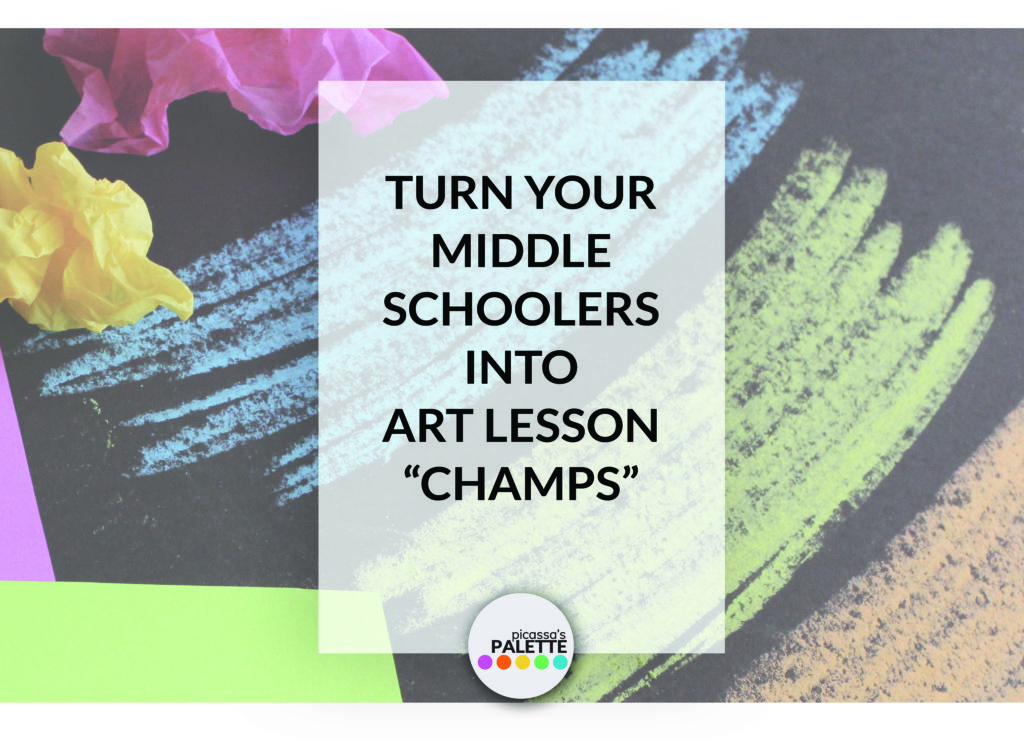
Imagine yourself walking by my classroom.
This is pretty much what you’d hear if it was an art classroom full of middle schoolers:
“WHAT ARE WE DOING TODAY… WAIT, WHAT?… I DUNNO WHAT TO DO… CAN WE TALK TO OUR FRIENDS?… CAN I MOVE MY SEAT?… IS THIS RIGHT? …WHAT DO I DO AGAIN? … WHAT ARE WE WORKING ON?”
And let’s just pretend you were recording some sound bytes of my voice when teaching art to those middle schoolers:
“I’VE ALREADY REPEATED THE DIRECTIONS NUMEROUS TIMES…WHERE WERE YOU FOR THE DIRECTIONS?…GET TO WORK PLEASE!…QUIET DOWN!…RAISE YOUR HAND! …I CAN’T ANSWER EVERYONE ALL AT ONCE!”
I thought…
“Maybe it’s because Art Class doesn’t follow a ‘traditional’ class structure?”
Or,
“Maybe they just don’t take my class seriously?”
These are just some of the excuses I’d tell myself for justifying the symptoms of an inefficiently managed classroom.
Ouch…
Hard to type.
But, it was my reality:
I’d struggled with how to balance concise directions with thorough explanations.
The funny thing is, I genuinely thought I was being clear to my students about my expectations.
Some Things I Tried:
- Handouts with directions. Didn’t work. The more info I gave, the more they were confused.
- Writing my directions on the board. Same thing- more info, but they got confused or couldn’t read my writing.
- Extensively explaining my directions- they’d always get hung up on something they thought I’d left out, but I thought I’d covered.
- Repeating objectives as a class- Nope. Just nope!
- Video demos- Cue the glares of student-turned-zombie eyes.
NONE of those things were effective in getting each student to be clear on what was expected of them.
I needed a new way!
Thankfully, I found out about a teaching strategy through a brief conversation with a fellow teacher.
I found out more about it, then used it to completely overhaul my middle school art classes.
The technique is called CHAMPS.
I’ve found CHAMPS to be immensely useful when teaching my middle school art classes.
CHAMPS can be used for any subject, really, but I find it especially effective for organizing the expectations of the Art Room.
It’s helped me communicate my standards for behavior in my classroom, and has helped me clarify the directions I give for art projects and lessons.
My students now know how to focus on the task. They can understand my expectations for the lessons when I use CHAMPS.
So what is CHAMPS?
*CITATION*
CHAMPS IS A METHOD USED AS PART OF RANDY SPRICK’S SAFE AND CIVIL SCHOOLS- A RESEARCH-BASED PROGRAM, which when incorporated into the classroom, results in a reduction in classroom disruptions, office referrals, negativity, off-task behavior, and disrespectful interactions.
The acronym CHAMPS stands for:
C = Conversation
H = Help
A = Activity
M = Movement
P = Participation
S = Success
CONVERSATION is the volume and topic that students can talk during the lesson.
HELP is the way they can get assistance with the project and what they should try before asking for assistance.
ACTIVITY is the tasks of the day, including the step (s) and order in which they should complete those tasks.
MOVEMENT is where and how they are allowed to move around the room.
PARTICIPATION is what engaged effort looks like and sounds like and (if applicable) how their effort will be graded during the class.
SUCCESS tells the student whether they’ve accomplished the task accurately and effectively.
How does it work?
My students can easily interpret CHAMPS by asking themselves these questions for each letter:
C
CONVERSATION = Can I talk?
H
HELP = How can I get help and what do I do while I wait?
A
ACTIVITY = What do I need to have done by the end of class?
M
MOVEMENT = Can I leave my seat?
P
PARTICIPATION = How do I show my full effort?
S
SUCCESS = If I ________, then I will know I am successful.
Now that I use the CHAMPS strategy, I can be absolutely clear on what I expect from my students.
The students know exactly what is expected of them, and they know what to expect from me.
How do you use it?
I define and review each of these things before work time at the beginning of each class.
They know that if they are not following CHAMPS, they are breaking classroom rules, and have consequences like moving their seat, coming in for recess to work or earning a lower grade.
Implementing the CHAMPS strategy took a little work on my part and some practice with my classes, but once I applied it, it didn’t take long to start seeing improvements in my students’ behavior and productivity.
If you ask them, (And I do, on their end of year Student Surveys!) they’d say they like CHAMPS and that it helps them complete their work more efficiently.
Soon, I’ll be offering a handbook called, Practical Strategies Toolkit: Manage Your Art Class. Sign up if you’d like future updates on this by subscribing to the newsletter.
and…
IF someone you know is looking for some basic classroom management tips for the Art Room, feel free to SHARE this post with them!
Have you had similar issues or revelations with your Middle School Art classes? Tell us your story!